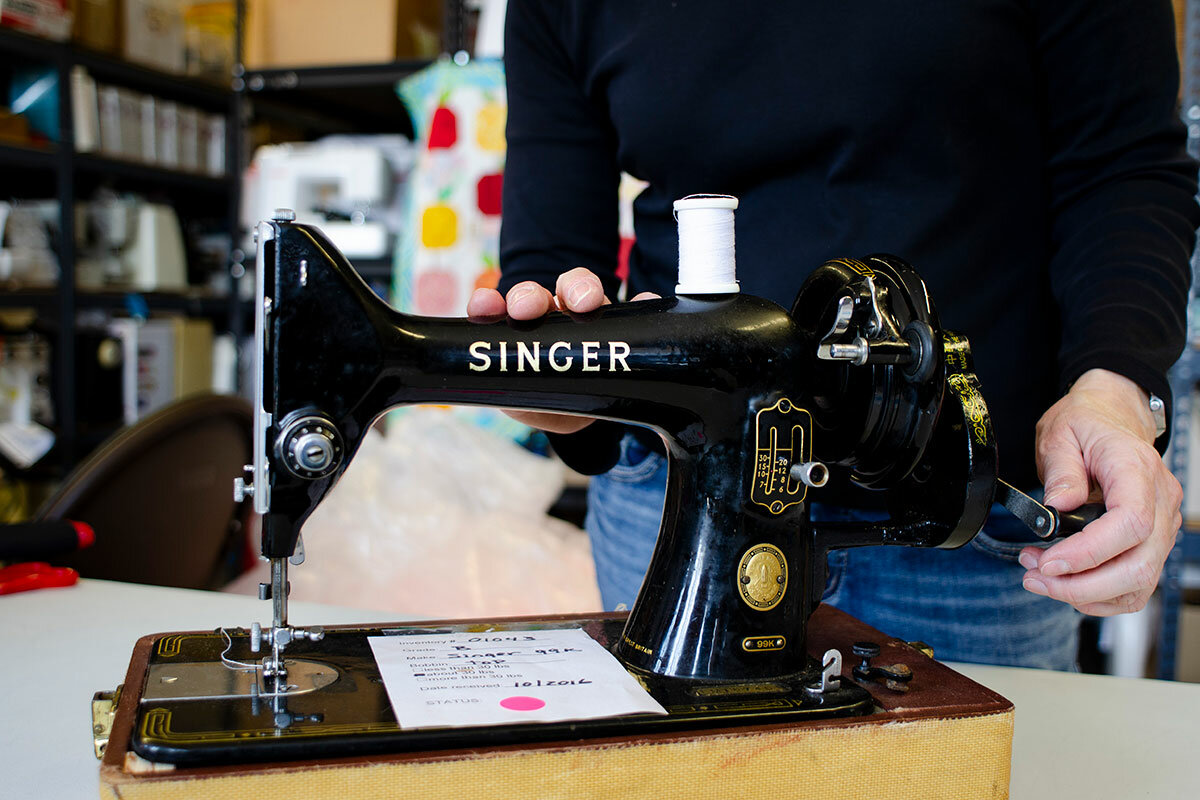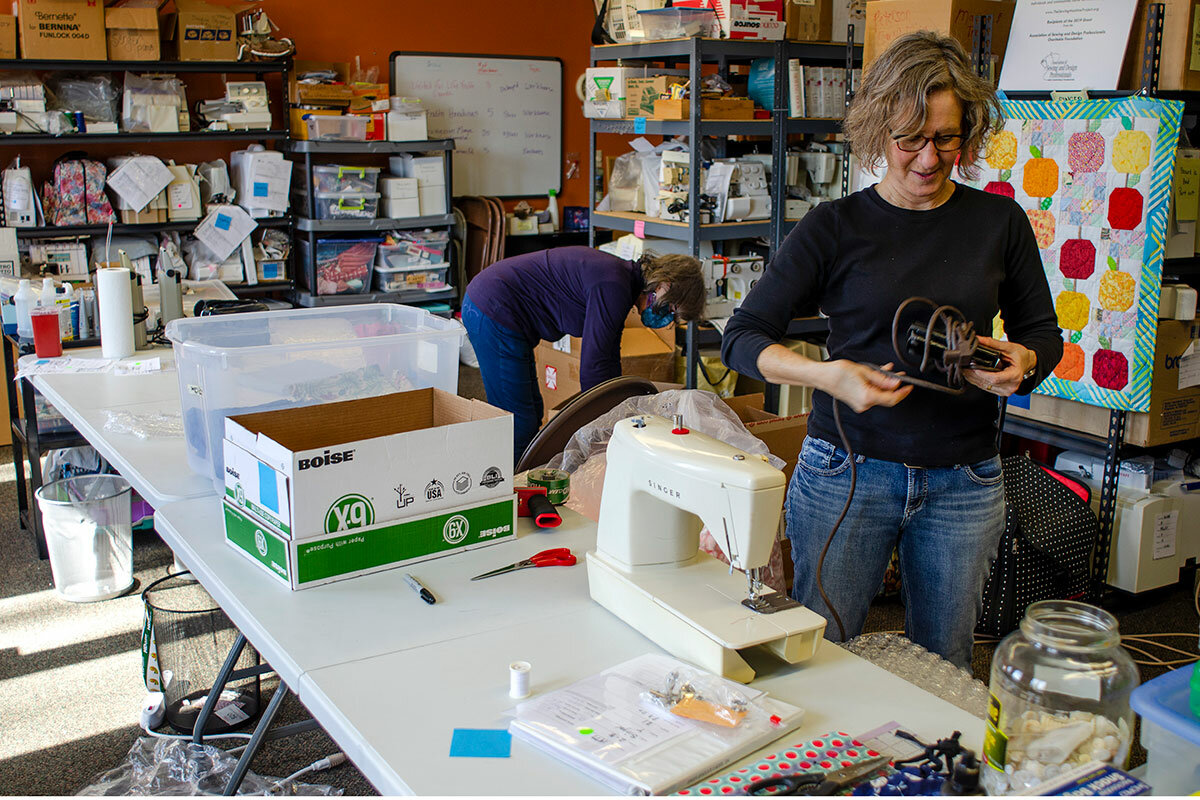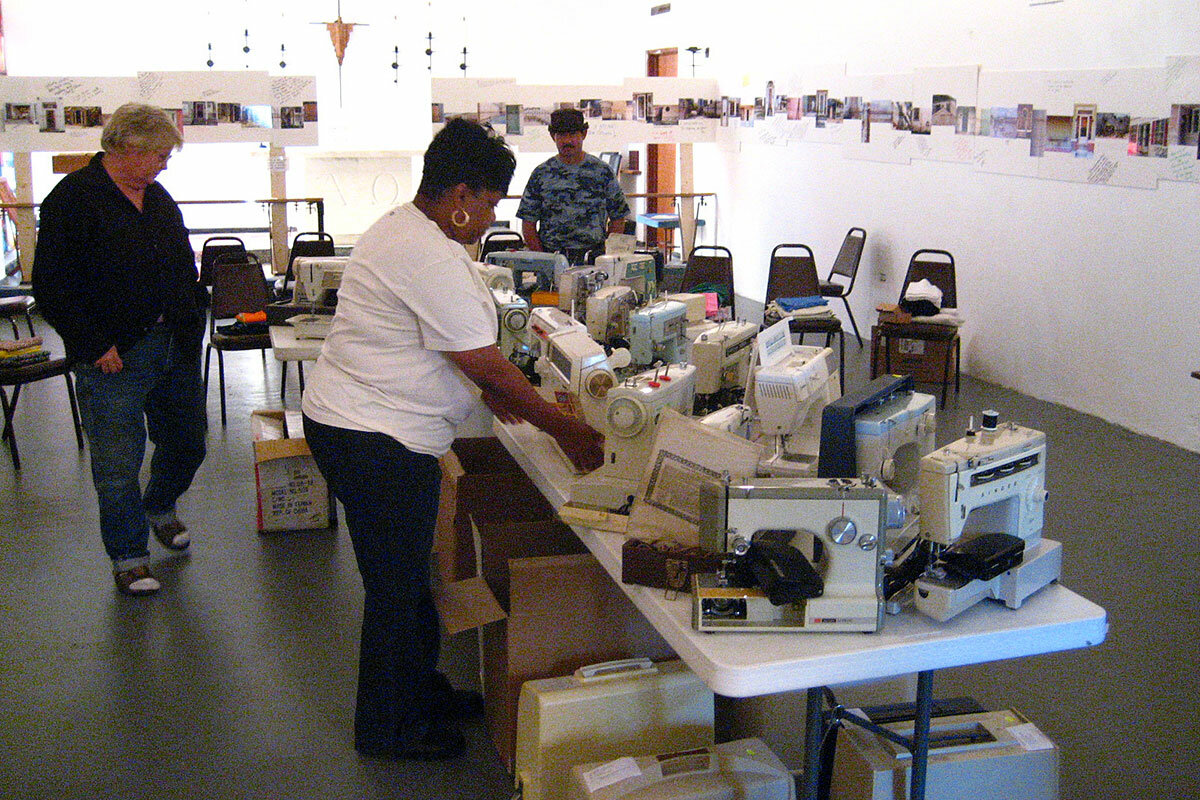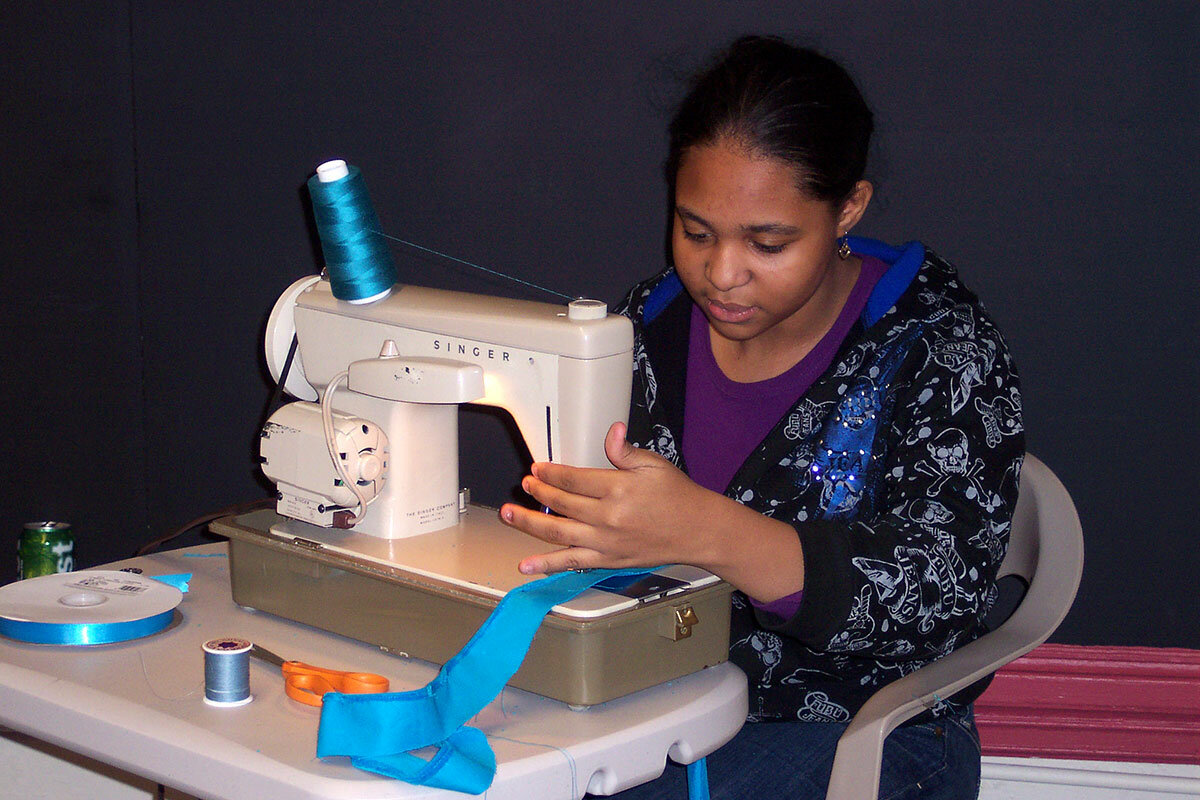Sew it goes: The Sewing Machine Project stitches lives back together
Loading...
| Madison, Wis.
A tsunami helped Margaret Jankowski understand the real value of a sewing machine.
Like many girls of her generation, she had learned to sew at an early age. Her mother taught her on an old Singer Featherweight, and she learned the basics by hemming her father’s handkerchiefs. As an adult, she bought her own clothes off the rack but sewed for her first child, crafting little woolen coats that impressed other mothers. She taught classes at a sewing shop, “preaching the gospel of sewing,” she says, including how to make “pajamas comfortable enough to live in.”
Then, in December 2004, a tsunami hit Sri Lanka and other coasts around the Indian Ocean, leveling communities, hurling wooden fishing boats far inland, and killing 230,000 people. Images of the destruction riveted viewers around the world. But what touched Ms. Jankowski most deeply was the story of a woman returning to her ruined village. The woman had worked for years to save enough to buy a sewing machine, enabling her to work as a tailor and giving her a future. Now it was gone.
Why We Wrote This
Earning a living does more than put food on the table and money in the bank. It builds pride and hope. The Sewing Machine Project helps people do both.
“I could easily make a living without my sewing machine,” Ms. Jankowski recalls thinking. “That wasn’t true of this woman.”
She resolved to send sewing machines to Sri Lanka. “I thought maybe I could collect a few of these machines that people are getting rid of anyway,” she says. She explained her idea on a local news program and was inundated with machines. She raised money for voltage converters and shipping, and in 2005, with the help of the American Hindu Association, sent five boxes each to five orphanages in India and Sri Lanka, each packed with toys, medical supplies, fabric, and the most precious cargo – a sewing machine.
“They were used to sew for kids,” she says. “They were also used to teach kids a trade, which I felt was really important.”
It didn’t end there. Ms. Jankowski went on to start The Sewing Machine Project, a small organization that redistributes used machines. It’s a mission that springs from a love for an old craft and a belief in its practical and redemptive possibilities today. “We look at ourselves as the ones who provide the tools,” Ms. Jankowski says simply.
In 16 years the project has shipped 3,350 machines around the world – and across town. It’s sent them to coffee pickers in Guatemala, women who help vulnerable girls in Guam, and war widows in Kosovo. It’s sent them to programs that help refugee women in Detroit, incarcerated women in Mississippi, and sewers of Mardi Gras outfits in New Orleans. It’s bundled them off to libraries.
In these and other places, unwanted machines find new uses. In many places sewing can be a livelihood, whether in a factory job or at home. For those trapped in poverty, Ms. Jankowski says, sewing “is a way out.”
“I made this”
Sewing is also a way forward for immigrant and refugee women in Detroit, says Gigi Salka. Ms. Salka is the director of the B.O.O.S.T. training program at Zaman International, a nonprofit that serves poor and marginalized women and children, including immigrants and refugees, in the Detroit area. In 2016, the group received 15 machines, plus an embroidery machine, a serger, and an industrial sewing machine, to start classes for refugee and immigrant women from Yemen, Syria, and other war-ravaged countries. Zaman began offering a two-year sewing instruction program. Graduates earn money doing alterations and creating made-to-order clothing, often from their homes.
“A lot of our clients have a lot of barriers – language, transportation, child care,” says Ms. Salka. “Entrepreneurship has done well for them.”
The pandemic disrupted the classes but also created new opportunities for the women. “We gave them fabric. They took machines home. They made masks,” Ms. Salka says. “In a population where five dollars makes a big difference, any supplemental income, any extra dollar is a dollar they can have.”
The sewing has helped the women in other ways, Ms. Salka says. “Sewing is very empowering. You see it in a population that’s lost hope; the ability to create a product is very powerful to them. They’re so proud. They walk around saying, ‘I made this.’”
This idea is being tested in Rankin County, Mississippi, where a local woman, Renee Smith, persuaded prison officials to allow her to start a sewing program for women in the Central Mississippi Correctional Facility. Her aim was to get help producing reusable menstrual pads for girls in countries like Uganda and Haiti where girls frequently stay home from school while menstruating, or quit school altogether because they lack access to sanitary supplies. Ms. Smith and the inmates prepared backpacks filled with menstrual pads and cotton underwear.
The inmates were glad to have something to do, she says, but sewing for distant schoolgirls also gave them a sense of purpose. Sometimes she brought photos of these faraway beneficiaries of their work. One inmate stuck a picture of a girl in Uganda to her sewing machine. “They know they’re making a difference in the life of someone else,” she says. “To me that’s huge.”
Recovery through sewing
Some of the biggest beneficiaries of The Sewing Machine Project have been the Mardi Gras Indians of New Orleans, an African American community known for the elaborate feathered and beaded suits they wear for Mardi Gras. That effort, too, started with a disaster. In 2005, Hurricane Katrina struck the city, hitting African American neighborhoods especially hard. Cherice Harrison-Nelson, also known as Queen Reesie and an early collaborator with The Sewing Machine Project, says that making Mardi Gras suits is an important cottage industry in the city, but that many people lost their machines in the hurricane.
“It’s [an] economic challenge when you don’t have your sewing machine that you make your hustle, or your side hustle, with,” she says. Since the hurricane, The Sewing Machine Project has given out hundreds of machines in New Orleans, many to creators of Mardi Gras costumes.
Other machines have ended up closer to home. Trisha Juisto was released from the Sauk County jail to a halfway house in Madison, where she joined a sewing class as she strove to overcome dependence on methamphetamines and cocaine.
She was nervous at first. In high school she had failed home economics, in part because she hadn’t finished a pillow case project. “I still had it in my mind that I screwed up as a kid, and that I can’t sew.”
But she persisted. She learned enough fundamentals to finally sew a tote bag, with straps and three pockets, two on the outside and one on the inside.
“I’ve got so many compliments on my bag,” she says. “It makes you feel really good.” She hopes to learn enough that she can someday take a machine home and sew on her own. She has children whose clothes need mending and altering; she also hopes to earn money by doing jobs for other people. “I want to learn how to fix clothes,” she says. “That’s a big thing.”
It hasn’t all gone smoothly at The Sewing Machine Project. There have been stumbles along the way, lessons learned. It had to tighten its guidelines for donations; the machines have to be fully functional. It found that programs that teach sewing, like Zaman International in Detroit, prefer just one kind of machine; a hodgepodge of Singers, Brothers, and Berninas just complicates the learning. That’s why in 2018 Ms. Jankowski solicited a gift of 500 new machines from the Brother sewing machine company – including 25 that went to Detroit.
Ms. Jankowski and a small group of volunteers run The Sewing Machine Project out of a Lutheran church on Madison’s south side, just across the street from Lake Monona. On a recent morning, Ms. Jankowski and Annette Bollig, a longtime volunteer, are there to pack up machines to send to Guatemala. Machines on racks crowd the room. The machines are tested and lubricated before they get sent out; those that fail are banished to the hallway. Big plastic bins holding huge quantities of sewing supplies sit stacked against the walls.
As the morning sun pours in, the two women swathe machines in bubble wrap and place them in cardboard boxes. Then they pack as much fabric and supplies around them as they can – spools of thread, buttons, tape measures, bobbins, seam rippers, and other essentials. “We’re kind of heavily loading this shipment with supplies because where they’re living they’re so remote,” Ms. Jankowski says.
She would like to do more. “I probably get 10 to 15 emails a week from international groups saying, ‘Can we get some sewing machines?’” she says. “We don’t have the money.” She dreams of starting sewing schools in villages, but says, “We can’t do that now.” Still, she’s a little taken aback when she reflects on how far the project has come since it started, on an impulse, really, after the 2004 tsunami.
“At the beginning I didn’t know if there was enough need,” she says as the day’s packing draws to a close. “Good Lord, there’s plenty of need.”
Visit TheSewingMachineProject.org to learn more.
Editor's note: This story has been updated to correct an attribution error. The comments from Zaman International were made by Gigi Salka.









